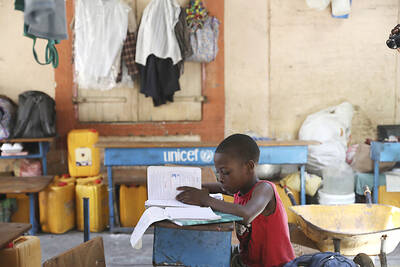When Indian national Prem Purswaney arrived in Taiwan, like many expats he only intended to stay for a short time. That was 23 years ago.
Prem, born in Rajasthan, but raised in Dubai, arrived in October 1985 to do a short-term apprenticeship with his uncle’s trading company.
Before long, six months had turned into six years. Then, in 1992 he met Priya, a fellow Indian living in Taiwan, who he married two years later.
The couple now have two children, a daughter, 10, and a five-year-old son — both born here — and are still in Taiwan. A place they have come to love and now call home.
“We even get homesick when we return to India to see our family,” Priya said.
Back in the early days, Prem said, Taiwanese people knew little about India and he often got annoyed at the stereotypes he faced whenever he took a taxi.
“Drivers would often ask why I ate with my hand, why Indian women had spots [bindis] on their forehead and about the hot and spicy food,” he said.
Nowadays, the same drivers are more likely to ask him about the IT industry and India’s expertise in computer software.
This is a sign of how things have changed, and the increasingly close relationship that has formed between the two countries as ties have increased over the last two decades.
“When our office opened in 1995, there was very little bilateral trade,” India-Taipei Association Director General T. P. Seetharam said.
By 2006, annual trade had grown to US$2.8 billion. Last year that figure had increased to US$5.38 billion.
“But there is still much room for improvement,” he added.
Surprisingly, software — considered one of India’s strengths — isn’t a large contributor to its trade with Taiwan.
Seetharam puts that partly down to language differences and the fact that Indian software companies usually concentrate on Western markets.
But, he added, there are many other exchanges, both industrial and academic, in high-tech fields such as biotechnology and materials technology.
These exchanges have led to a mini influx of Indians into Taiwan, with small groups of Indian nationals springing up in several locations near the country’s larger universities, most notably in Hsinchu and Taipei.
“There are almost 100 Indian scientists alone at Academia Sinica,” he added.
Rajendra Prasad Janapatla, 32, from Hyderabad, has been in Tainan for three years conducting post-doctoral research in microbiology at National Cheng Kung University.
Raj, as his friends call him, said he enjoys life in Taiwan as it is much less hassle than in India, although he believes the locals, though friendly and helpful, are too shy when it comes to socializing with foreigners.
Like most expats here, Raj also has a few complaints.
“Many Indians complain that they only get seven days paid vacation per year,” he told the Taipei Times by e-mail. “Visa extensions are also annoying,” he said, “because if a contract is for 12 months, the authorities only give you 12 months, not one or two months extra like in the US or Europe.”
In addition to these high-tech newcomers, “There are two major Indian communities which have been here for longer,” Seetharam said.
First, there is “a community of traders — who buy and sell things around the globe,” he added. This community (which speaks the Sindhi language) used to have around 200 families, but now numbers only 40 or 50 as the majority of them have migrated to China, mainly to Guangzhou, along with Taiwan’s manufacturing.
Another, similar-sized, group is made up of families in the diamond and precious stones trade who sell their wares to Taiwanese jewelers.
Despite the increased contacts, it may surprise many to learn that according to official immigration figures, as of last August there were only around 1,900 long-term Indian residents in Taiwan — although this number had increased from 1,400 a year earlier.
Even so, signs of an increased awareness of India and its culture are visible on the streets of Taiwan’s cities.
Yoga is one of the most obvious examples, with schools devoted to the ancient art literally on every other corner. Inspiration from Bollywood movies, meanwhile, has seen Indian dancing gain an increasing number of devotees.
Indian fashions are popular among the young and can be purchased at most night markets, while those who fancy some pampering can check into one of the many ayurvedic spas that are cropping up in big hotels and beauty salons nationwide.
Chengchi University is working on a textbook about India — its politics, economics and culture — with the aim of helping the nation’s university students gain a deeper understanding of this giant melting pot of a country.
Then there is Indian food, which can now be found at more and more locations across Taiwan.
“Even the Indian fare on offer at some of Taipei’s Western restaurants is pretty authentic,” Purswaney said.
With so much bilateral contact these days, it seems the only stereotypes Indians in Taiwan like Purswaney will have to put up with in the future will be positive ones.

POLITICAL PRISONERS VS DEPORTEES: Venezuela’s prosecutor’s office slammed the call by El Salvador’s leader, accusing him of crimes against humanity Salvadoran President Nayib Bukele on Sunday proposed carrying out a prisoner swap with Venezuela, suggesting he would exchange Venezuelan deportees from the US his government has kept imprisoned for what he called “political prisoners” in Venezuela. In a post on X, directed at Venezuelan President Nicolas Maduro, Bukele listed off a number of family members of high-level opposition figures in Venezuela, journalists and activists detained during the South American government’s electoral crackdown last year. “The only reason they are imprisoned is for having opposed you and your electoral fraud,” he wrote to Maduro. “However, I want to propose a humanitarian agreement that

ECONOMIC WORRIES: The ruling PAP faces voters amid concerns that the city-state faces the possibility of a recession and job losses amid Washington’s tariffs Singapore yesterday finalized contestants for its general election on Saturday next week, with the ruling People’s Action Party (PAP) fielding 32 new candidates in the biggest refresh of the party that has ruled the city-state since independence in 1965. The move follows a pledge by Singaporean Prime Minister Lawrence Wong (黃循財), who took office last year and assumed the PAP leadership, to “bring in new blood, new ideas and new energy” to steer the country of 6 million people. His latest shake-up beats that of predecessors Lee Hsien Loong (李顯龍) and Goh Chok Tong (吳作棟), who replaced 24 and 11 politicians respectively

Young women standing idly around a park in Tokyo’s west suggest that a giant statue of Godzilla is not the only attraction for a record number of foreign tourists. Their faces lit by the cold glow of their phones, the women lining Okubo Park are evidence that sex tourism has developed as a dark flipside to the bustling Kabukicho nightlife district. Increasing numbers of foreign men are flocking to the area after seeing videos on social media. One of the women said that the area near Kabukicho, where Godzilla rumbles and belches smoke atop a cinema, has become a “real

‘POINT OF NO RETURN’: The Caribbean nation needs increased international funding and support for a multinational force to help police tackle expanding gang violence The top UN official in Haiti on Monday sounded an alarm to the UN Security Council that escalating gang violence is liable to lead the Caribbean nation to “a point of no return.” Special Representative of the UN Secretary-General for Haiti Maria Isabel Salvador said that “Haiti could face total chaos” without increased funding and support for the operation of the Kenya-led multinational force helping Haiti’s police to tackle the gangs’ expanding violence into areas beyond the capital, Port-Au-Prince. Most recently, gangs seized the city of Mirebalais in central Haiti, and during the attack more than 500 prisoners were freed, she said.